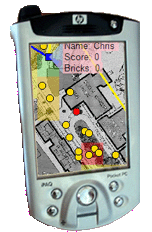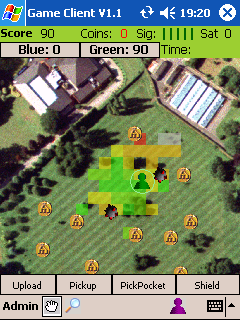|
Seamful Game is a GPS and WiFi based game
exploring the concept of seamfulness, in which we harness
negative aspects of infrastructure technologies, which are
normally concealed and unexplained, and present them as game
features allowing users to explore and understand them.
Equator
University of Glasgow, UK
Matthew Chalmers, Marek Bell, Barry Brown, Malcolm Hall,
Scott Sherwood, Paul Tennent
Demos at Ubicomp 2004, MobileHCI2004
and WMCSA 2004
 The
Concept The
Concept
The Seamful Game is a GPS and WiFi based game played in the
streets using PDAs. It began life as a project to test an
idea about exploiting and exploring the seams of an 802.11
wireless network. Now approximately one year on, Bill is a
fully featured multiplayer team game, which has been accused
of being fun to play. Players must develop an understanding
of the network coverage and the effect of signal strength in
order to successfully play the game. In this way we are
turning the patchy network coverage, which is usually seen
as a problem to be overcome, or worse ignored, into a
feature (indeed possibly the main feature) of the game.
The Game
 The
game consists of two teams of ‘runners’ each of whom is
given a PDA equipped with 802.11b WiFi and GPS. Players
travel around a designated area collecting digital ‘coins’
and uploading them in exchange for points. The team with the
highest total at the end of the game wins. Each player is
provided with a zoomable and panable map of the game area,
displaying their own position and the positions of the other
players in the game. ‘Coins’ appear all over this map,
including those places not covered by the 802.11b wireless
network. Players must use their GPS positioning to navigate
to where the coin is displayed, and collect it using the
'pickup' button on the PDA interface. In The
game consists of two teams of ‘runners’ each of whom is
given a PDA equipped with 802.11b WiFi and GPS. Players
travel around a designated area collecting digital ‘coins’
and uploading them in exchange for points. The team with the
highest total at the end of the game wins. Each player is
provided with a zoomable and panable map of the game area,
displaying their own position and the positions of the other
players in the game. ‘Coins’ appear all over this map,
including those places not covered by the 802.11b wireless
network. Players must use their GPS positioning to navigate
to where the coin is displayed, and collect it using the
'pickup' button on the PDA interface. In
order to gain the points from
collecting the coin, players must then successfully upload
it to the server. To do this requires the player to press
the 'upload' button on their interface in an area where
there is 802.11b coverage. It is with this distinction that
we introduce the concept of seams to the players. Only by
understanding the boundaries of the network, and the effect
of signal strength on their ability to upload coins, and
thus score points, will players be successful in winning the
game. If players attempt to upload coins in an area not
covered by WiFi, the upload fails and they loose all the
coins they are carrying.
 In
order to encourage users to interact while playing the game,
two additional features are provided, one collaborative and
one competitive. The first is a collaborative upload. This
feature allows users to upload coins simultaneously with
other members of their team to receive a points bonus (each
player receives the cumulative total points for the upload)
and the more team members participate, the more points they
stand to gain. The players are given a three second window
in which to upload their coins, to get the bonus. The second
feature added was the ‘Pick Pocket’. This proved one of the
more popular and certainly one of the most discussed
features of the whole system. The ‘Pick Pocket’ allows a
player to steal coins from other players nearby. To use it a
player must be inside network coverage, and use his or her
GPS to get within 10 meters of another player (also within
network coverage). He or she then presses the 'Pick Pocket'
button on the PDA and the any ‘coins’ the victim is carrying
but has not uploaded are transferred to the PDA of the
perpetrator. Players may ‘Pick Pocket’ as many times they
wish. As well as ‘Pick Pockets’, players face another hazard
along the way. Scattered infrequently around the map are
‘Mines’. If a player moves to within 10 meters of a ‘mine’,
it will detonate, causing the player’s PDA to be temporarily
disabled. ‘Mines’ are displayed clearly on the map, but can
be obscured by a large cluster of coins if the map is zoomed
too far out. This means that mines can be hidden, but if
players are suitably aware, they will be able to avoid them.
One method of staying safe from ‘Mines and ‘Pick Pockets’ is
the ‘Shield’. When a player presses the 'shield' button on
their PDA, they cannot be affected for 20 seconds. However
once the time runs out, the ‘shield’ must be ‘recharged’ in
an area of network coverage before it can be used again. In
order to encourage users to interact while playing the game,
two additional features are provided, one collaborative and
one competitive. The first is a collaborative upload. This
feature allows users to upload coins simultaneously with
other members of their team to receive a points bonus (each
player receives the cumulative total points for the upload)
and the more team members participate, the more points they
stand to gain. The players are given a three second window
in which to upload their coins, to get the bonus. The second
feature added was the ‘Pick Pocket’. This proved one of the
more popular and certainly one of the most discussed
features of the whole system. The ‘Pick Pocket’ allows a
player to steal coins from other players nearby. To use it a
player must be inside network coverage, and use his or her
GPS to get within 10 meters of another player (also within
network coverage). He or she then presses the 'Pick Pocket'
button on the PDA and the any ‘coins’ the victim is carrying
but has not uploaded are transferred to the PDA of the
perpetrator. Players may ‘Pick Pocket’ as many times they
wish. As well as ‘Pick Pockets’, players face another hazard
along the way. Scattered infrequently around the map are
‘Mines’. If a player moves to within 10 meters of a ‘mine’,
it will detonate, causing the player’s PDA to be temporarily
disabled. ‘Mines’ are displayed clearly on the map, but can
be obscured by a large cluster of coins if the map is zoomed
too far out. This means that mines can be hidden, but if
players are suitably aware, they will be able to avoid them.
One method of staying safe from ‘Mines and ‘Pick Pockets’ is
the ‘Shield’. When a player presses the 'shield' button on
their PDA, they cannot be affected for 20 seconds. However
once the time runs out, the ‘shield’ must be ‘recharged’ in
an area of network coverage before it can be used again.
Along the top of the PDA’s display is shown state
information. The player’s own score, the two team’s total
scores, the number of coins currently carried and the time
remaining in the game is shown, along with the current
signal strength and the number of GPS satellites available
(equating roughly to GPS accuracy). Finally, the players are
provided with an instant messaging system. Players can
scribble notes, using Pocket PC2003’s built in handwriting
recognition (or explicitly type them), then send to either a
whole team or an individual.
Displaying the Signal Strength
Two approaches were taken to displaying the 802.11b signal
strength. As mentioned in the previous section, a subjective
view of signal strength is provided; this is in the mobile
phone-esque form of signal bars and shows a player’s
immediate signal strength. This actually served a dual
purpose. It was reasoned that this would be easy to
understand, and perhaps more usefully provided a connection
to mobile phones, helping us to explain the idea of seams in
networks in easy to understand terms (e.g. Highlighting the
idea of being outside network coverage, or pretending to
be…and missing a call). The second method of display used
was slightly more complex. The idea of signal coverage maps,
such as those used by mobile phone companies, was taken and
expanded to create something more dynamic. Traditionally
these maps show us the best possible coverage, not taking
into account the fact, that wireless networks are distinctly
malleable. In this system, players build up a collaborative
aggregate map of the signal strength across the game area as
the game is played. By leveraging the power of the
technology we are using, we are able to display the most up
to the minute data possible, as the map is being constantly
updated from all the players within network range. This
second display gives players a more objective view of the
network. Instead of thinking ‘I can upload my coins here’
they are now able to think ‘I can upload my coins there’.
This dynamic mapping has great potential for system
understanding. Imagine if a phone company with thousands of
users in every node could see these maps of their network.
The granularity could be extremely fine, and far more
accurate than the current systems mentioned earlier. |